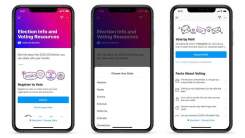How to Use the Best New Google Home App Features
Google Home version 2.27 adds a bunch of new features to the app, including new in-app controls for Nest home security products on iOS and Android and

Selling or trading a used Android phone is a smart way to safely dispose of your old devices, and hopefully earn some extra cash you can put towards your next upgrade. But there are a few things to take care of before offloading your old phone—including backing up and deleting your data, cleaning it, and finding the right seller or trade-in offer.
Sounds simple enough, but the variety of Android “flavors” out there makes this process messier than it is for iPhone users. As such, the names and locations of the settings we cover in this guide may differ on your phone or version of Android, but the general guidelines are the same. If you can’t find something, use your phone’s search bar to look up the right settings, and if that doesn’t work, check for guides online specific to your device.
The first step is to back up your data—including your contacts, texts, app data, photos, and other files stored on your phone. The process has pretty much the same steps as in our video guide on backing up personal data on Android (and iOS), so feel free to check that out, as well.
There are a few ways to backup an Android phone, but Android’s built-in backup tool is the simplest; it uploads your data to your Google Drive (or other apps) so you can import it to your new phone later.
Many users will have automatic backups turned on, but you can manually create a backup under Settings > System > Backup. This menu also shows the most recent backup made, and which types of data are included. Make sure you toggle every option under “Backup details” to ensure nothing gets left behind, then select “Back up now” to save your data.
Do note that you may not have enough space to back up everything on your phone for free, at least if you’re using Google Drive or Google One Drive. Everything you back up counts against the free 15 GBs allotted to every Google account, but buying additional space is inexpensive.
That said, if you want to keep things free but you’re struggling with the 15 GB limit, the best option is to back up your phone’s photos and videos elsewhere. Google Photos will automatically back your phone’s images, but the app now counts additional cloud uploads against your Google Account’s storage limit, and photos and videos are likely the biggest chunk of data on your phone. Instead, find an alternative cloud service or manually move your photos to your PC via USB.
The next step is to remove your Google Account from the phone. Make sure you perform this step after backing up your data, since you won’t be able to sync your files to the cloud after removing an account. Luckily, the removal process is pretty easy:
Go to Settings > Accounts.
Select your Google Account from the list.
Tap “Remove account.”
Repeat for any additional accounts synced to the phone.
With your data backed up and your Google Account unlinked from your phone, you can now perform a factory reset. This wipes your data, files, and installed apps from the phone’s internal storage, and reverts all settings back to their off-the-shelf defaults. You can perform a factory reset even if your phone’s screen is totally trashed, but we’ll show you how to do it assuming the device is still in full working condition.
Go to Settings > Advanced > Reset Options
Select “Erase all data (factory reset).”
The next screen will show you everything that will be deleted. This is your last chance to back any lingering data.
Tap “Erase all data” to begin the process.
With your phone’s insides cleared out, now it’s time to deal with its external parts.
This is pretty straightforward. Begin with removing any cases, screen covers, and other accessories attached to your phone, then remove the SIM card. Steps for this will differ between devices, but most require a tiny pin key to open the SIM card slot. These tiny tools usually ship in the original box, but you can also buy them online; or go to a certified repair location, tech assistance desks at stores like Best Buy, or your phone carrier’s nearest store. Oh, and don’t forget to take out any micro SD expansion cards if you happen to have a phone that supports expanded storage options.
Now it’s time to clean the phone. Our guide on safely sanitizing electronics can help if you’re not sure what to do, but the general rule is to avoid liquid cleaners, since moisture damages electronics, and chemicals like alcohol, bleach, and ammonia can affect plastic and glass. A simple microfiber cloth wipe-down will remove thumbprints and smudges, and a dry q-tip can help remove dust or grime.
This is also a good opportunity to assess the device’s quality. Make note of any dents, cracks, or scratches ahead of time so you can get an accurate appraisal in the next step. You should also confirm you still have the phone’s original packaging and any accessories that it shipped with, such as chargers or headphones. These aren’t required to sell the phone, but including them can increase the final trade-in value.
Your phone is now ready to trade-in, but the question is: to where? There are a few different options, and some may fetch a better offer than others, but it ultimately depends on what you plan to do with the trade-in value.
If you plan to use the old phone’s value as credit towards a new phone, check out your service service provider’s trade-in programs. T-Mobile/Sprint, AT&T, Verizon, Google Fi, US Cellular, and others let you trade in old phones and use the value for your next purchase—only certain models may be eligible, however, and only if they’re in good condition.
For those buying directly from a manufacturer, you can sell back old versions of the company’s phone for credit. For example, Samsung lets you trade in your Galaxy phones, and Google accepts Pixel trade-ins. Though, again, there may be restrictions.
Similarly, retailers like Amazon, Best Buy, GameStop, and Walmart have trade-in programs, as well, and you can use your gift card credit to buy anything on their websites.
If want to sell for cash rather than store credit, there are plenty of third-party resellers you can use as well, including:
Decluttr
Flipsy
Gazelle
UpTrade
These companies will buy your old phones for cash. Payout is based on your phone’s condition and current market value.
The last option is to sell the phone directly to someone else yourself. A direct sale can sometimes be a better deal, as you get to set the price yourself, but there’s no guarantee you’ll make a sale.
There are plenty of websites that facilitate online sales safely, such as Swappa, eBay, Facebook Marketplace, or even Amazon and Back Market if you’re a professional refurbisher. These websites normally offer some form of fraud protection and transaction guarantees.
You can also go the riskier route and post to Craigslist, or online forums, subreddits, Telegram channels, and Discord servers dedicated to after-market resales. And if all else fails, post it on social media and see if your followers are interested. However, there’s always a possibility for scams, fraud, and other abuse when using websites and services like these, so be careful if you go this route.
Whoever you sell or trade your phone to, the last step is to get the phone ready and ship it—unless you’re trading the phone in in-person, in which case you can just walk into the store.
Manufacturers, service carriers, and third-party resellers will provide you with shipping instructions, and often free labels you can print at home. As for selling it to someone on Craigslist or eBay, you’ll have to take care of the shipping on your own. Your local post office, or companies like UPS and FedEx, can help you package everything up and ship it—just know you’ll be paying for the shipping yourself.
Once the package is in the mail, all that’s left to do is wait for whoever you sent it to to receive it.

Google Home version 2.27 adds a bunch of new features to the app, including new in-app controls for Nest home security products on iOS and Android and

The 2020 presidential election is November 3, meaning the clock is ticking for voters who need to complete or update their registration. The good news

Since Disney+ launched in 2019, the streaming service has acquired over 86 million paid subscribers, and this month at Disney’s Investors Day event th

Last year, Apple offered a free one-year subscription to their streaming service, Apple TV+, with the purchase of any eligible Apple device, giving mi

Smart phone notifications can be overwhelming. They can also be, well, boring, hidden away as little rectangles at the top of your screen and looking

One of the great things about iCloud is that you can store lots of pictures. One of the bad things about iCloud is that you can store lots of pictures

As my family’s in-house tech support center, I know that it’s easy for certain family members to get overwhelmed when their electronics aren’t doing w

As cool and convenient as wireless charging can be, boy is it slow. We’ve talked about how inefficient wireless charging is, especially compared to tr
We are a comprehensive and trusted information platform dedicated to delivering high-quality content across a wide range of topics, including society, technology, business, health, culture, and entertainment.
From breaking news to in-depth reports, we adhere to the principles of accuracy and diverse perspectives, helping readers find clarity and reliability in today’s fast-paced information landscape.
Our goal is to be a dependable source of knowledge for every reader—making information not only accessible but truly trustworthy. Looking ahead, we will continue to enhance our content and services, connecting the world and delivering value.